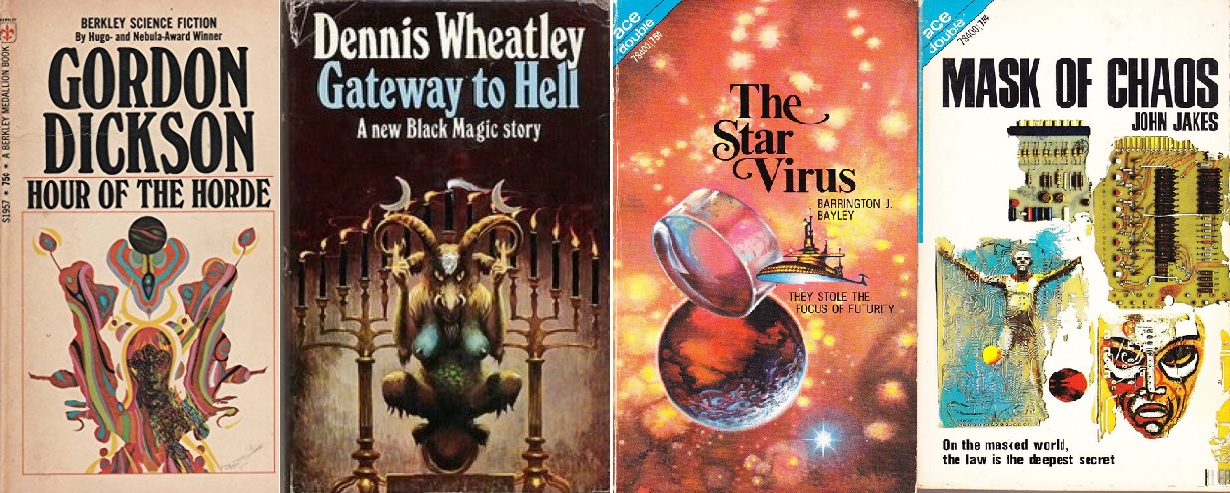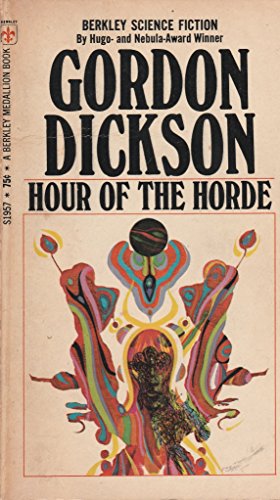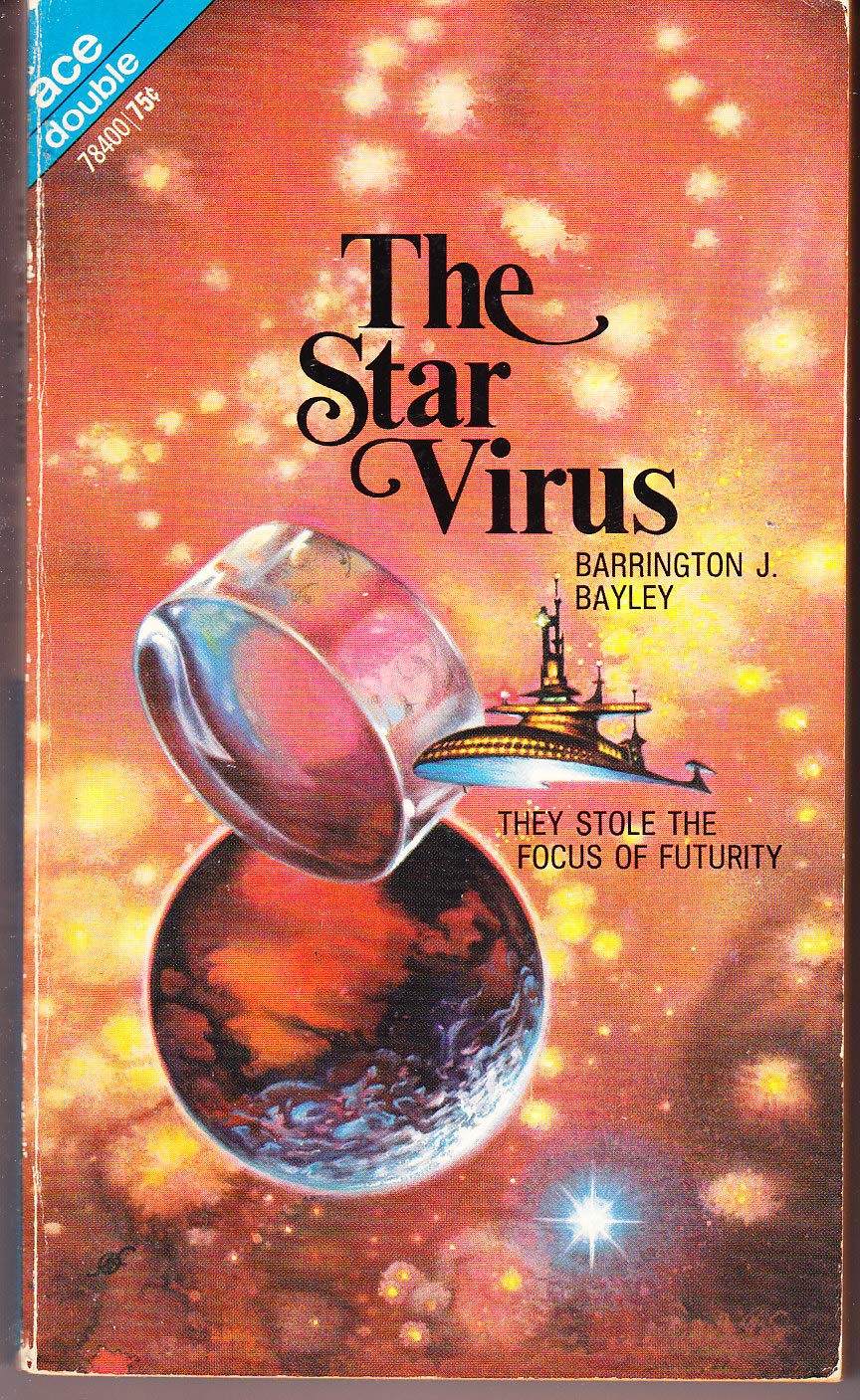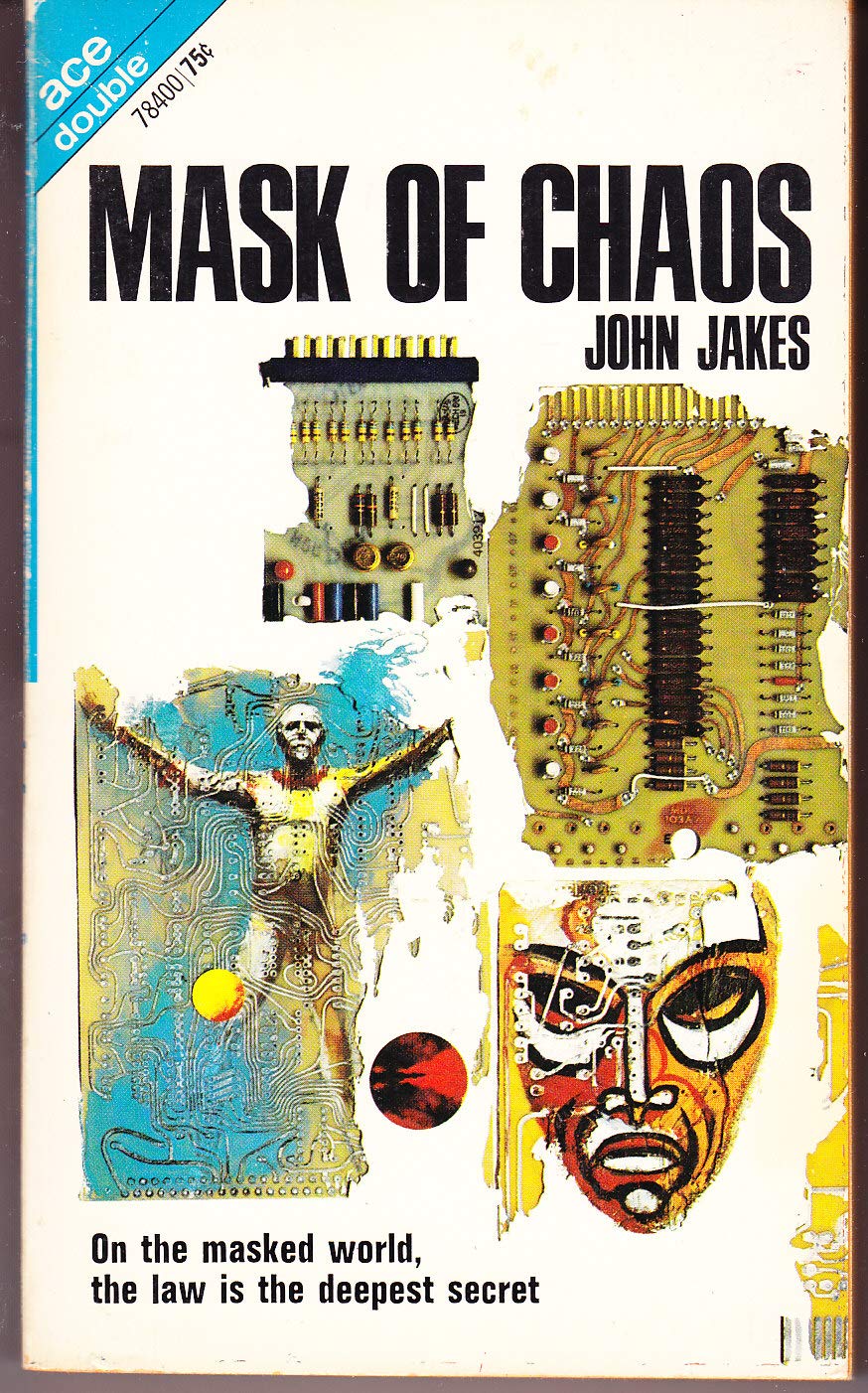Are you finding us from Worldcon?
Join us in Portal 55 (a great deal of DISCORD there…) for weekly broadcasts and perennial discussion!
This month's Galactoscope round-up of science fiction offers up some familiar names, some new names, and heights that don't exactly soar along with depths that don't precisely plump. See what's worth your six bits, and what should be left on the shelf this August!


by Maureen Hogan
Hour of the Horde by Gordon Dixon

[Originally published, perhaps in a truncated form, in the May 1969 Venture]
Our story opens with Miles Vander, a misanthropic artist in the throes of painting his next great work. He is obsessed with a single goal: to channel hysterical strength into his art. In this adrenaline-fueled state, he hopes to capture the true essence of reality onto his canvas. (Is this a tad pretentious? Yes. The man is an art student. Pretentious comes with the territory.) Before his lofty ambitious can burn him out, the unthinkable happens. No, no, Miles doesn’t lose his spark or suffer some blow to the ego. The Sun just spontaneously turns red.
Turns out, this change in the Sun is a byproduct of alien visitors (dubbed The Center Aliens). They come with a warning: a massive horde of weasel-like aliens is coming to consume everything in its path. (The titular Horde being a bunch of weasels sounds funny, but fighting millions of armed weasels with space ships actually sounds kind of terrifying.) One man has been selected to represent the Earth in the fight against the Horde. He shall take on the task of empathizing with all humanity, transforming himself into the “Every Man”. (I just knew Miles was going to be forced to develop empathy. I felt so smug when the narrative proved me right.)
Miles isn’t initially defending the Earth for any noble reason. He only wants to defend the Earth because if there’s no Earth, then there’s no one to appreciate his art. Honestly, I’m glad Dixon chose to make this Miles’ motivation. It’s much more believable than having him change his ways after one conversation with the Center Aliens. Miles does eventually (and predictably) grow to care about humanity, but that’s only after he becomes their representative. In a way, he takes ownership of the collective concerns of our species.
Inevitably, he’s able to connect with the other aliens on his crew and inspire them with his passion and grit. They become a proper fighting crew instead of a psychic power source for the Center Aliens. (Turns out the Center Aliens are condescending jerks who look down on “barbarian” species like us). But when the time comes for Miles and his crew to face down the Horde, will their barbarian instincts be what saves them in the end? The answer may not surprise you.
Overall, I would describe this as a comfortable sort of book. You know what you are going to get into and you’re gonna have a good time.
4 out of 5 stars.

by Victoria Silverwolf
Prolific British author Dennis Wheatley has been offering the world thrillers and novels of the occult since the 1930's. His best known work may be The Devil Rides Out (1934), adapted into a film a couple of years ago.
That book featured the character known as the Duke de Richleau. He and his three buddies (Simon, Richard, and Rex) have shared many adventures in multiple novels. Some of these are mysteries or spy stories, without supernatural elements. Others delve into black magic. The newest volume in the series is definitely of the latter variety.
Gateway to Hell, by Dennis Wheatley

The year is 1953. The plot begins with the news that Rex has stolen a million bucks from an Argentinian bank and disappeared. This seems extremely unlikely, so Simon and Richard set off on an excursion throughout South America.
Long story short, they meet lots of people, one of whom will turn out to be the story's main antagonist. The most interesting may be a former movie actress of the 1930's, who will play a more ambiguous role.
Along the way, Simon falls in love with a woman who was severely burned in an accident some time ago, leaving her nearly blind. She'll eventually be our Damsel in Distress.
This odyssey leads to our heroes witnessing a satanic ritual, complete with an orgy and the sacrifice of an ape. They rescue a young woman who innocently stumbled into this mess. Without giving too much away, let's just say that Simon and Richard wind up accused of murder.
We're about halfway through the book. The Duke finally shows up and rescues his pals, using a combination of white magic and an act of forgery. His ability to communicate with the dead offers clues as to what happened to Rex.
Here's where the novel is going to raise some eyebrows. It seems that a bunch of do-gooders, hoping to win civil rights for racial minorities, have fallen into the clutches of satanists. We're explicitly told that the Black Power movement (a term that seems anachronistic for 1953) is really a conspiracy of devil worshippers planning to start a race war.
Wow. We've had a hint of the author's right-wing leanings during the trip through South America, with criticism of the government of Juan Peron (although there's an expression of sympathy for the recently deceased Eva Peron.) This, however, really takes the cake. The Duke also speaks against interracial marriage, while claiming he believes all people should be treated as equals.
Let me try to ignore that for now. The second half of the book involves our heroes getting captured by the bad guys and undergoing all kinds of supernatural torment. The big climax involves the opening of a literal pit of Hell, in order to release the demonic beings within.
The author writes in a plain style, something like pulp adventures of decades past. There's a fair amount of padding. Much of the first part of the book reads like a tourist's guide to South America. The characters often stop to engage in philosophical discussions.
During these talks, both the good guys and the bad guys agree that modern Christianity is a distortion of the true religion. There's mention of fairies (a lost race of small humans.) We're told Joan of Arc really was a witch, but not a bad one. The Duke frequently mentions the Lords of Light, without explaining who or what they might be. The background is a real hodgepodge of the occult.
The scenes of satanic rituals are vivid, and the author doesn't shy away from their sexual aspects. There's a lot of supernatural stuff going on, from zombies and mind control spells to a lost temple of Atlantis.
A tough book to rate, given its…reactionary view of the Black Power movement. Let's call it two stars, I guess. The Hell with it.

by Amber Dubin
Ace Double 78400
This Ace Double was unusual. Both books were long, a bit dense, and I at first had a hard time discovering what caused them to be paired. By the end, however, I realized the connecting message: knowledge and technology are poisonous and the pursuit of them is reckless, selfish, and will lead to one’s doom.
The Star Virus, by Barrington J. Bayley,

cover by Freas
[Originally published, perhaps in a truncated form, in the July-August 1964 New Worlds]
The Star Virus by Barrington J. Bayley was my favorite of the two, mainly because the protagonist was unique, charismatic, and likeable. It also possessed a story that progressed at a steady clip, following the journey of extremely capable space pirate Rodrone and his quest to acquire and understand an ancient alien artifact. In Rodrone’s cutthroat existence, humans have discovered a nexus of habitable worlds so plentiful that it’s spread the species across the galaxy in innumerable quantities. Humankind has spread so far and wide over the last several hundred years that no one remembers the exact location of earth and society itself has completely lost track of an over-arching governmental structure. This causes problems when they begin to encounter the only other space-faring race, the Streall, a highly organized, elite and ancient bug-like society whose members live for thousands of years and seem to regard humanity as an invasive species.
Rodrone firsts runs afoul of the Streall when he hears of an artifact being carried on a human merchant ship he was already planning on robbing. Once he discovers the Streall are after the ship, however, he becomes much more interested in the unknown object than the rest of its contents, and he recklessly steals the artifact alone. It turns out that what the Streall were desperately trying to retrieve from the human vessel was a glass lens roughly the size of a human child, with strange projections that play scenes all over its surface.
Unsure whether these scenes are past, present, future, or fiction, Rodrone quickly becomes obsessed with the object, poring over it for hours and slowly losing perspective of his place between it and the rest of the world, like man turned mad staring into an abyss that blinks back. Spurred on by this obsession, Rodrone embarks on an Odyssey-like quest to unravel the mystery of the lens, piece by piece dismantling his loyal crew, his empire and his very humanity in exchange for this knowledge.
I was enthralled by the way the author managed to bounce between Rodrone’s descent into madness and thrilling chase that Streall maintained throughout, as the Streall proved themselves to be just as relentless and self-destructive in their pursuit to re-acquire the lens from Rodrone as he maintained in his passion to control it. I loved the subtle way the flaws in the universe’s structure are unraveled, peel by peel, just as the sinister nature of the Streall and their lens come into view. The fact that the object they were fighting over was a lens was an apt metaphor in itself, and I thoroughly enjoyed the way Barrington Bayley made me question mankind’s role in reality, purely by zooming out my perspective.
I really enjoyed how well-crafted and exciting this book was, but I have a personal bias for good endings and this story lost a point for the sickly-noir feeling it left me with in its final pages.
4 stars
Mask of Chaos, by John Jakes

cover by Gaughan
Mask of Chaos by John Jakes, while more delicately crafted, was also a bit more of a slog to get through than the other story that shares its bindings. For one thing, I found the protagonist distinctly less likeable and harder to relate to. Mike, short for Micropig, is a cyborg spacer whose original design can be summed up as optimistic naivete. Though he barely knows his own name, we come to know him as he is being violently ejected from his latest shipping assignment, having been voted out by his jealous crewmates who believe his mechanical abilities give him an unfair advantage in comparison to their output.
Despite this injustice, Mike strolls onto the planet he’s stranded on in a cloud of blissful ignorance, as it is implied that the scientists that mechanized his originally human body edited out similar memories that might cause the average man to be bitter or hold a grudge. The planet in question, named Tome, initially appears to match his pink-clouded attitude: the streets are quiet and litter free, the air is citrus-scented, and all the citizens that walk among these clean, quiet streets are adorned with placid, beautiful, metal masks.
He allows his surroundings to put him at ease, despite the fact that he is newly unemployed, stranded, and isolated by being the only one without the anonymity of a richly forged mask. This ease quickly slips from his grasp as he is introduced to the method upon which the city’s order is maintained, and he is greeted at his hotel by masked government workers. They explain to him how limited his options are, as tourists are few and far between and employment for a non-local is even harder to come by, implying that he is destined for destitution without a solid plan that they are happy to present him with. Said plan is called the Game, a televised simulation where a brainy contestant is matched with a brawny one and they are set out to solve puzzles for live broadcast and viewing pleasure of the entire planet’s several billion inhabitants.
Feeling unsettled by the lack of details and established rules he is provided, he withdraws to weigh his options and ends up meeting his intended partner for the exercise, a fiery redhead going by the nomme de plume Beloved Abattoir, Ab for short. In addition to being brilliant and a striking beauty, the counter-culturalist is a space-faring, failed poetess, and escort, all things the orderly, artificially controlled Tome society has no valid place for. Mike quickly falls under her spell and before he knows it, he is bending his previously unquestioned moral code to find some less-than-legal alternative means of survival on the sanitized planet.
After a failed heist, they find themselves back in the offices of the same government officials attempting to lure them into the Game with a carrot, now with their only option being the stick. They then enter the Game as partners, hoping to beat it following the apparent order that the society appears to be built on, only to discover that this order is only a thin film barely containing the true chaos that lurks beneath.
I was particularly impressed by how the twists and turns of the plot were not predictable enough for me to be able to guess at the ending, but something that this story had in common with its counterpart was another downbeat ending. I really enjoyed how interplayed all the metaphors were but I would have liked more uniqueness of thought from the main characters and I resented the implications of Eve being wrong for biting the apple.
3.5 stars
[New to the Journey? Read this for a brief introduction!]




